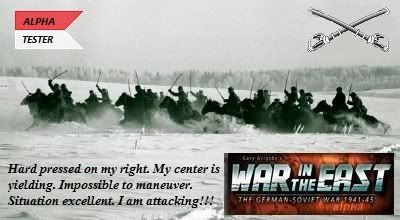ORIGINAL: Adnan Meshuggi
Yes, you are true... now think about 40miles deep entrenchments with 100 or more lanes of mines... that is (if you dig in 4hexes deep as russian player for 1000miles =400 Units/hexes) incredible... in a 10miles-deep hex you need alone 20 belts... so we have 4x of the numbers you said - the result of this is: 240 million mines... nice. How should the russians produce em? And - again 1000miles, 40 miles, how long are the trenches? To dig in, you need say for each mile (in the depth!) 1 or 2 miles of trenches... this is: 40x1000x2=40-80.000miles of trenches... well, i tink someone has really to like digging. The barbwire... yeah...
i agree totally that the fortification levels (in depth) are silly and not realistic
So the best solution is, that you need Industrypoints... without you have only level1, level2 (in the moment the level1 of the game) needs so and so much points each hex, level3 (between 2 and 3) needs 10times the stuff, level 4 (3 in the game) needs 10times the stuff of level 3 and so on. (the multiplicator is just a random guess.... but if you want to build a deep fortification zone, you need a lot ressources, time and transportation stuff.
War is a complex business. For a human player to be able to run the millions of men of the entire East Front, the complexity of the real life war has to be accommodated not only to our limited individual capacity, but also (among other things) to the limited memory space of our email server. This means that the game tries to model, rather than replicate exactly each single detail. The tricky part is choosing the set of variables that model the reality in the most cost effective manner.
When a unit prepares for a battle, it digs, recognizes the terrain, selects the most appropriate points for machine-guns, pre-targets the artillery, deploys minefields, sets barbed-wire barriers, establishes duplicate telephonic lines, and does a lot of other stuff that is basically abstracted in the game as a single variable : the fort level.
We players tend to assign a physical reality to each abstraction included in the model ( the ZOC, the location of a HQ, the rail points, the blizzard penalties, the administrative points…). For each player, though, the translation is made in a different way. For some players a Fort 4 is like a warmed chateau and therefore it is absurd that it does not confer protection during blizzard. For other players a Fort 4 is like a thematic park of the minefield, and even calculates the millions of mines necessary to fort the front, to arrive at the conclusion that the game is silly (nothing that surprises me), at least in this aspect.
What matters here is, in my opinion, the effect of that model in the game. Is it reasonable for a unit to duplicate, triplicate, quadruplicate, etc…its defensive potential in n1, n2, n3 weeks? I have zero idea of this, and I have read nothing in this thread that gives light to that point. To define what is reasonable, I would think that the best way would be to chose the n1, n2, n3 numbers that better reproduce (model) the events in the whole war, rather than calculating the metric tons of concrete that would be necessary to build a linear bunker.
Big Anorak said that the fine tuning of the building speed was very cumbersome (a yo-yo affair, if I recall correctly). Perhaps precisely that is why the developers left that as an option for the players to play with. I tend to think that perhaps some hard discussions in this forum could have been avoided if the developers had left more optional settings included in the game (e.g: manpower multipliers, blizzard penalties). But, as matter of fact, since as proud players we do not accept to play under any conditions different from the 100% “normal” settings, we want them to give us the “correct” answers, and leave that “parameter adjusting” only for playing the AI.
Somewhat lazy from our part (except Altaris and his 35% settings).






